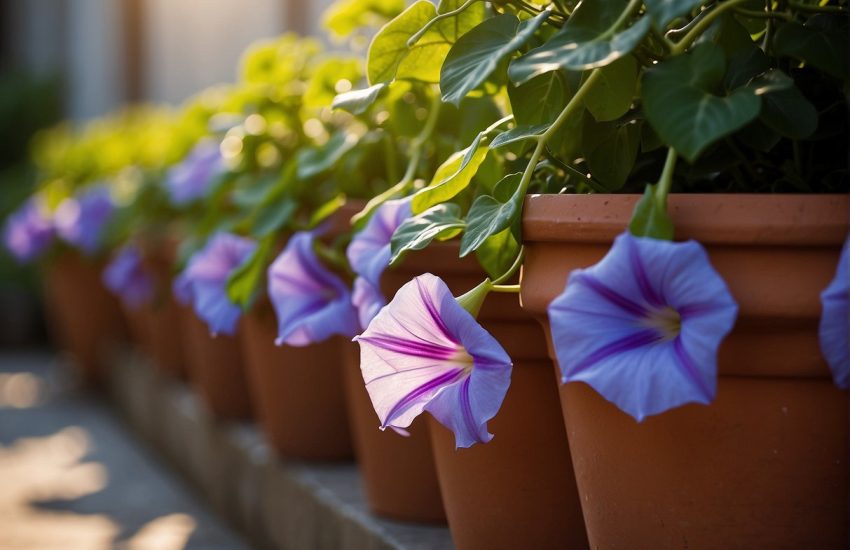Flowering Vines That Will Thrive in Georgia
Flowering vines are must-have plants for gardeners in Georgia since this state has an abundance of native flowering vine species that grow there. Gardeners and designers can make dramatic changes to any landscape and display blossoms that are produced from spring to fall and even winter.
Whether you are in the mountainous northwest part of the state or down in south Georgia where it can get wet and swampy, you will find vines growing all over the state. You will commonly find that people in Georgia tend to grow flowering vines on trellises, porches, arbors, fences, and deck railings.
There are several flowering vine species that are native to Georgia that easily adapt to the specific four seasons of this region. Other non-native flowering vine species also thrive in this area. However, it is recommended to focus on native flowering vines since some non-native species are invasive and pose a threat to many native plant species that are already endangered or threatened.
When choosing flowering vines to grow, make sure to choose plant species that are grown from local sources. You cannot go wrong with species that are grown by others who live in the area, and know how to identify and even discuss with you how to best maintain them and most importantly, avoid evasive species.
At all costs, you should do your best to avoid invasive species because they do serious harm to the environment and natural habitat. You should also be aware that non-native species consume more water and resources and do not provide any benefit to the natural habitat where they grow.
Here is a list of flowering vines that are excellent for growing in Georgia.
Wisteria Frutescens (American Wisteria)
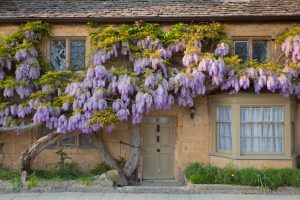
The Wisteria is a flowering vine that is native to the Eastern United States and grows vigorously up to thirty feet tall and eight feet wide. It can be identified by its large grouping clusters that produce stunning images of lilac white and purple flowers that are packed with fragrance. It climbs in a counterclockwise motion from right to left and twines as it climbs up which makes this flowering vine a strong climber.
American Wisteria should not be confused with other species that are more aggressive, and invasive such as Chinese Wisteria or Japanese Wisteria. Flowers tend to appear during late spring or early summer after the leaves have appeared.
Wisterias thrive in full sun with their lance-shaped leaves that are shiny and dark green. These vines grow well in fertile soil that is well drained and tolerates some seasonal flooding. Wisteria flowering vines are excellent for growing on fences, walls, arbors, pergolas, or trellises.
Gelsemium Sempervirens (Carolina Jessamine)
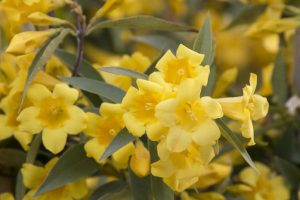
From late winter to early spring, and sometimes fall, you can see the spectacular blooms of the Carolina Jessamine’s yellow trumpet flowers. This evergreen twining climber produces blossoms sporadically that are sweetly scented and provide a beautiful display for any garden or landscape design. The blooms are often a beautiful deep golden yellow or butter yellow and are often produced in clusters or sometimes solitary.
Carolina Jessamine can grow up to twenty feet tall and three feet wide. These vines thrive in full sun or light shade with rich organic soil that is well-drained and maintains moisture. To get the best display of flowers, it is better to grow these vines in full sun.
Many gardeners tend to use the Carolina Jessamine for climbing trees, porches, deck railings, covering garden structures, scrambling over fences, or trailing along the ground to form a carpet. It can also be used to cascade over walls for large containers or help control erosion on banks.
This particular vine is also very strong and also known as the ‘poor man’s rope’. It was popularly used throughout American history and was commonly used in the South to make rope.
Lonicera Sempervens (Trumpet Honeysuckle)
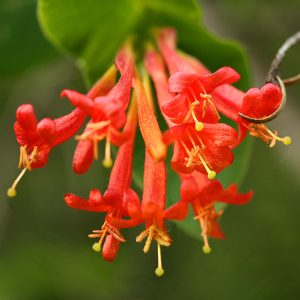
This flowering vine is stunning and creates incredible floral arrangements. This flowering vine is really impressive, starting early spring to early summer, with its masses of scarlet tubular flowers that reveal bright yellow throats. During a full bloom, these flowers appear in clusters that are two inches in length and located at the tips of the stems.
When the flowers fade away, bright red berries will appear usually in late summer or early fall to provide an additional ornamental attraction until the berries are devoured by birds. The flowers do not give off a fragrance but definitely show a cheerful side of nature. They happily attract bees, butterflies, hummingbirds, and other natural wildlife while producing foliage of blue-green leaves that are smooth, oblong, and glossy and contrast well in any garden.
This flowering vine is evergreen and can grow up to fifteen feet tall and six feet wide. It does best in well-drained soil and does tolerate some shade but prefers full sun. This flowering vine is not invasive which makes it excellent for covering fences, walls, trellises, and pergolas without having to worry that it is going to take over your whole yard. It is also very popular among gardeners in Georgia because it will continue to put out flowers all summer and it is highly attractive to hummingbirds.
Clematis Virginiana (Virgin’s Bower)
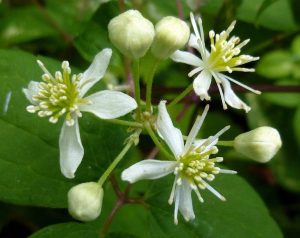
Also known as ‘Devil’s Darning Needles’ or ‘Old Man’s Beard’, this flowering vine produces clusters of small white flowers that grow in a plume-like, feathery star shape that is beautiful and amazing to see on display. The feathery tails and plumes combined with its bright green trifoliate leaves give the flowers on this vine a stunning appearance that you can often see along moist riverbanks and roadways.
As a climbing flowering vine, this species is unsurpassed for its long flowering presence in addition to its flower combinations of colors and shapes. Flowering begins in late summer based on the growth it has made during the season.
These flowering vines are extremely popular among gardeners because there are more than 300 species of this type of vine and also hundreds of hybrids. The Virgin’s Bower is an excellent choice for a vine that you would like to train on a wall, trellis, fence, or arbor. Many gardeners enjoy putting these vines in containers because they can be trained and trimmed. One main reason the Virgin’s Bower is most loved is that it flowers almost every month of the year.
Clitoria Mariana (Atlantic Pigeon Wings)
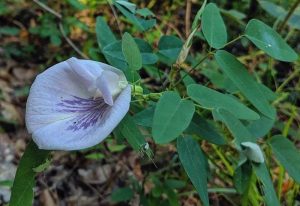
This perennial vine is highly distinguishable with its lavender-pink flowers that come in a pea-like shape and are two inches across with a white spot in the center. Blooms can be found in early to late summer and the most attractive blossoms are seen in clusters of 3 or as single flowers on the leaf axis. Its leaves can be distinguished by 3 lance-shaped leaflets that are arranged under the blossom.
This plant is often confused with the Centrosema Virginianum (Spurred Butterfly Pea) which can be distinguished by its upside-down flowers and its banner pointing downwards whereas the Clitoria always stands erect.
The Clitoria is very easy to grow and can be found in pine or hardwood forests, roadside banks, scrub oak woods, sandhills, and in a variety of different garden and landscape decorations. It grows up to four feet tall and three feet wide and performs best in partial shade or full sun using moist, well-drained soil.
Trachelospermum Jasminoides (Confederate Jasmine)
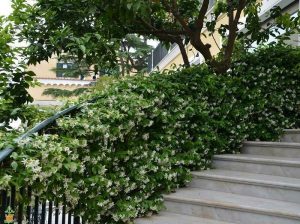
This evergreen vine is adorned for producing vigorous, abundant clusters of star-shaped white flowers that give off a sweet fragrance. These flowers are usually one inch in width and change into a cream color as they age. Flowers normally appear in the late spring and occur sporadically thereafter. The vine can be recognized by its glossy, oval, dark green leaves that sometimes turn purple or red during cold weather.
Vines grow up to two feet tall when spreading on the ground and growing naturally. It can grow up to twenty feet high when growing up a structure such as a wall or trellis. This species prefers full sun or partial shade in fertile soil that is well-drained. It is also drought tolerant.
This flowering vine is most commonly used by gardeners and homeowners to create a more natural look for any outdoor scene such as privacy fences, concrete walls, decks, arbors, among other designs
Campsis Radicans (Trumpet Creeper)
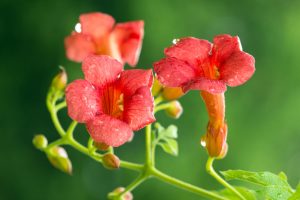
A self-clinging woody climber, the Trumpet Creeper is a favorite among gardeners and landscapers because of its distinct showy, trumpet-shaped flowers that are always attractive and glowing. If you want hummingbirds visiting your home, this is the best flowering vine to get. One of the main reasons is that it provides a long-lasting floral display that is stunning, spectacular, and attracts tons of wildlife especially hummingbirds and you can expect them to never stop visiting.
Bignonia Capreolata (Cross Vine)
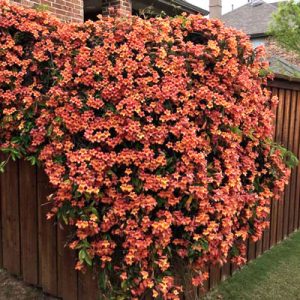
This climbing vine is known to reach up to fifty feet high and is distinguished by its orange-red, trumpet shaped flowers that hang in clusters of two to five. You can be reminded of these flowers and identify this type of vine because it grows quite high and you may have to look up high in a tree in order to see the flowers.
The leaves on this fine also create a dramatic appearance because they are persistent starting with a glossy, semi-green color that later changes to dark green in the summer or purplish-red in the winter.
Another Distinguishing Factor about this fine is that it has holdfasts (adhesive pads) that allow the vine to stick to fences, bricks, and stone without any support.
Clematis Viorna
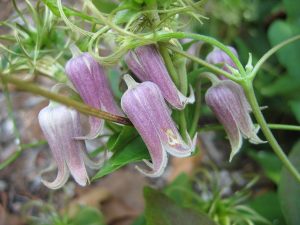
This climber is a perennial that boasts an urn-shaped lavender to reddish-purple flower that seems to nod at you in the wind. Blooms usually began in late spring and flowers are one inch wide and come with cream petal tips that curve out and have many stamens. Small elliptical, dark-green leaflets create an ornate decoration to produce a charming look for gardeners.
When growing this vine you must remember that the heads prefer the sun and the feet like to stay in the shade. It prefers soil that is moist and well-drained and grows in either. full sun or partial shade. Blossoms usually appear in late spring or early fall.
Passiflora Incarnata (Wild Passion Flower)
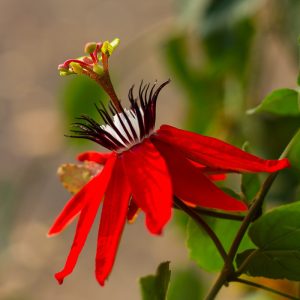
This vine is popular for its three-inch wide pinkish purple flower that is full of petals and sequels. Its blooms give off a wavy yet beautiful, unique appearance. The flowers are really distinct and unique on this vine and very attractive to not only viewers but also to natural wildlife including hummingbirds, bees, butterflies, and other pollinators. You can expect your garden to be bursting with activity in the spring when you plant this vine along a fence, trellis, wall, or arbor.


